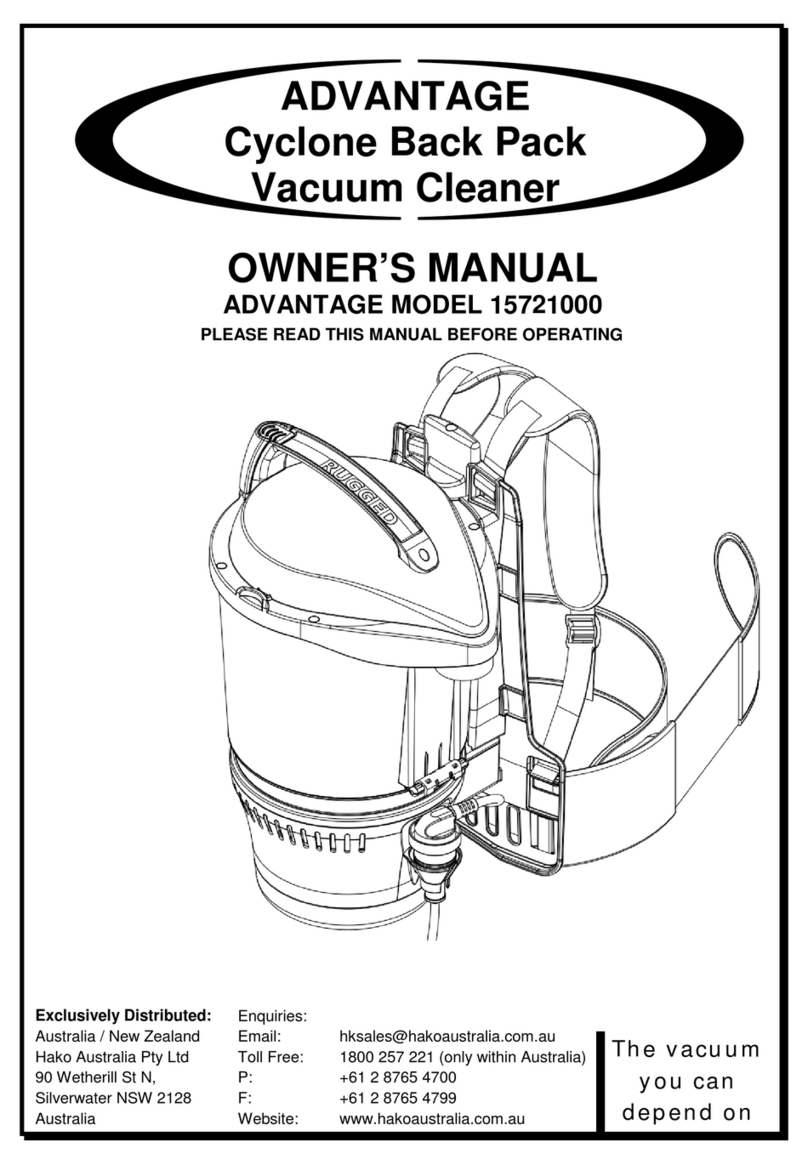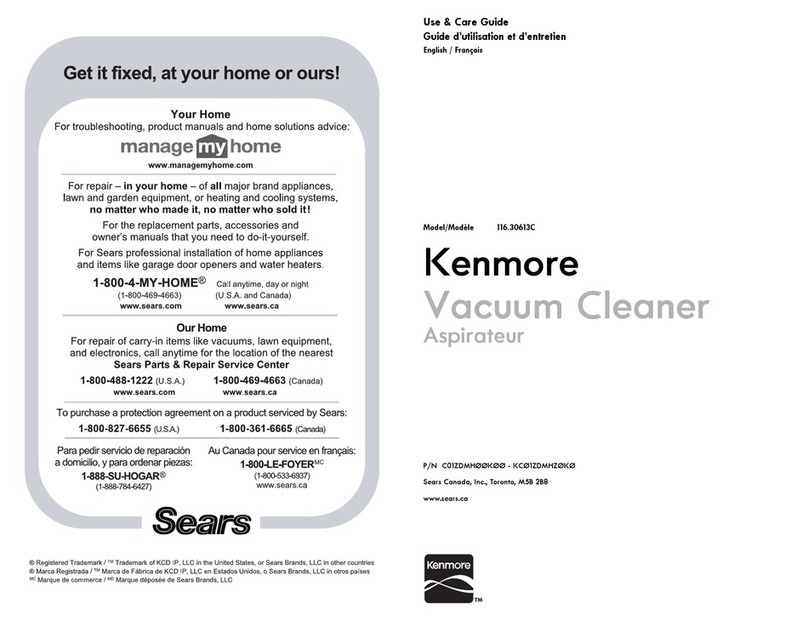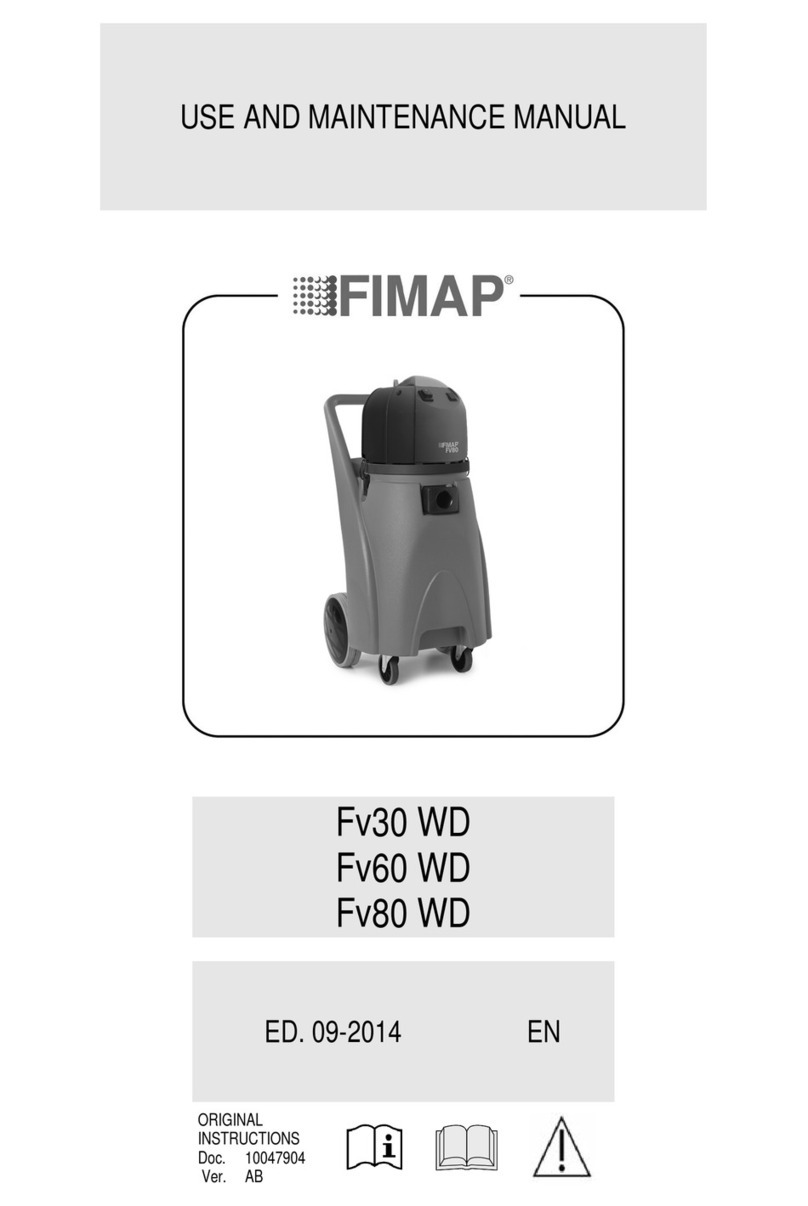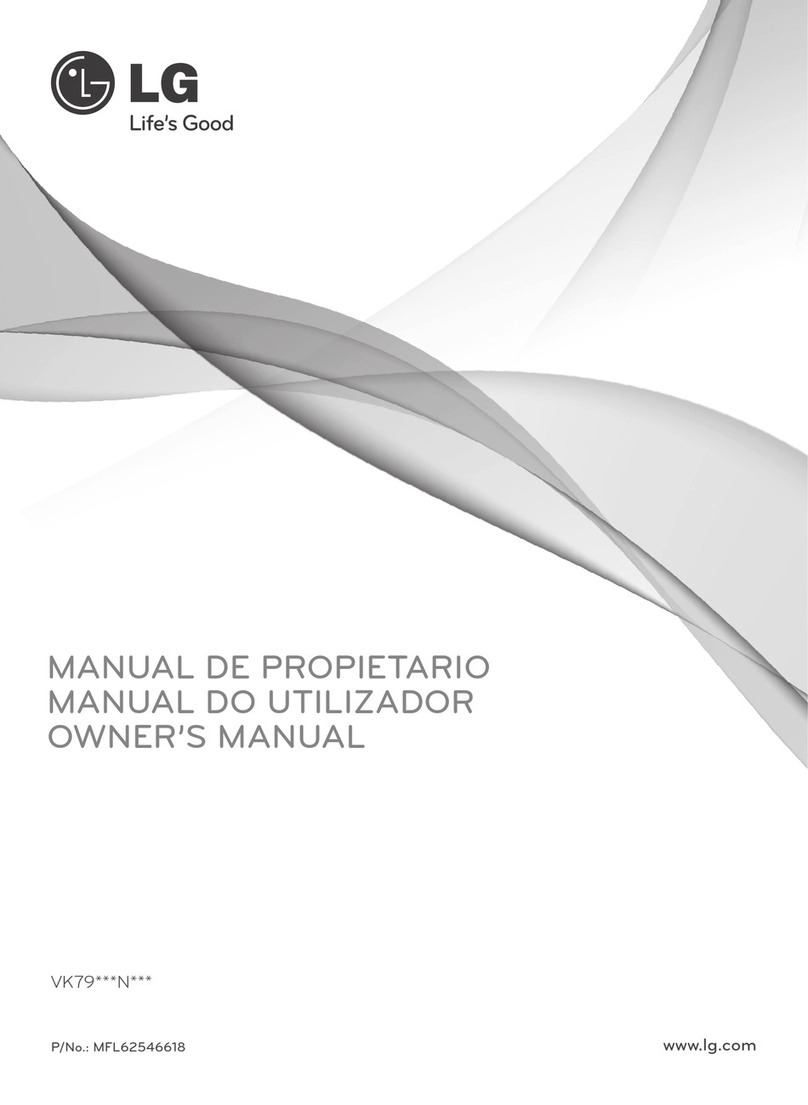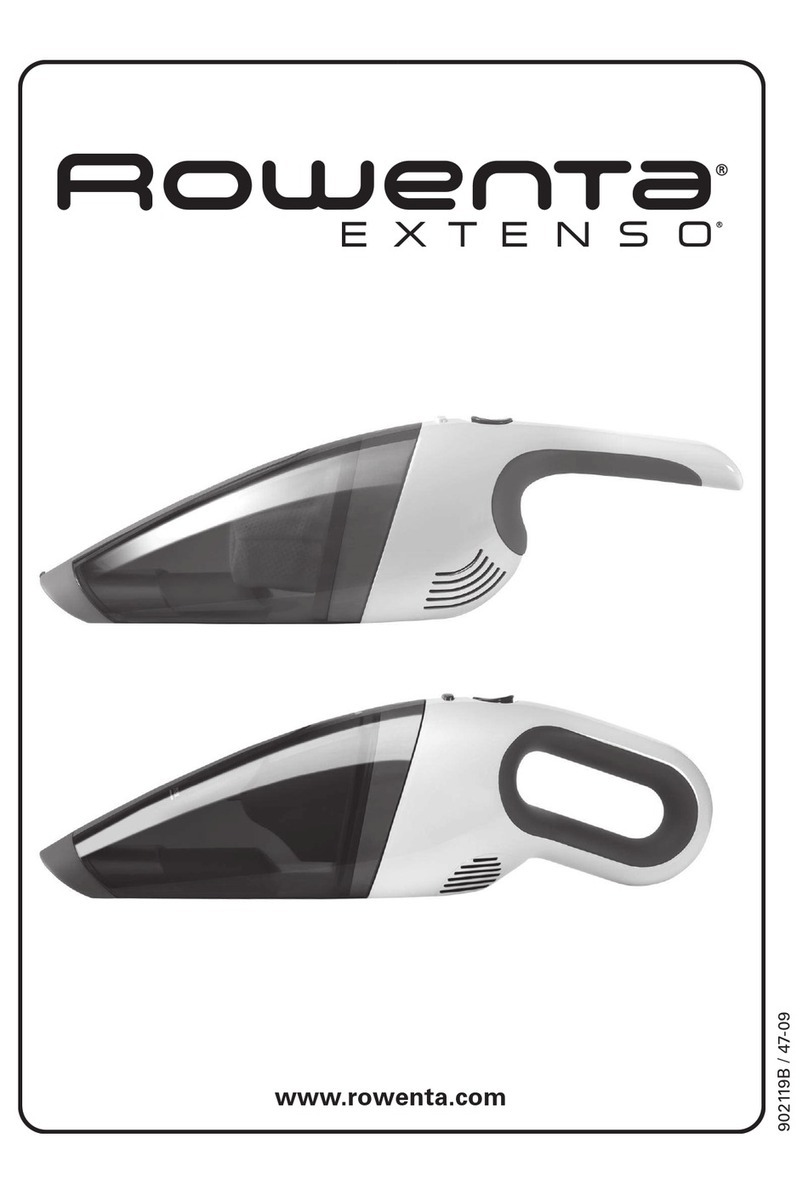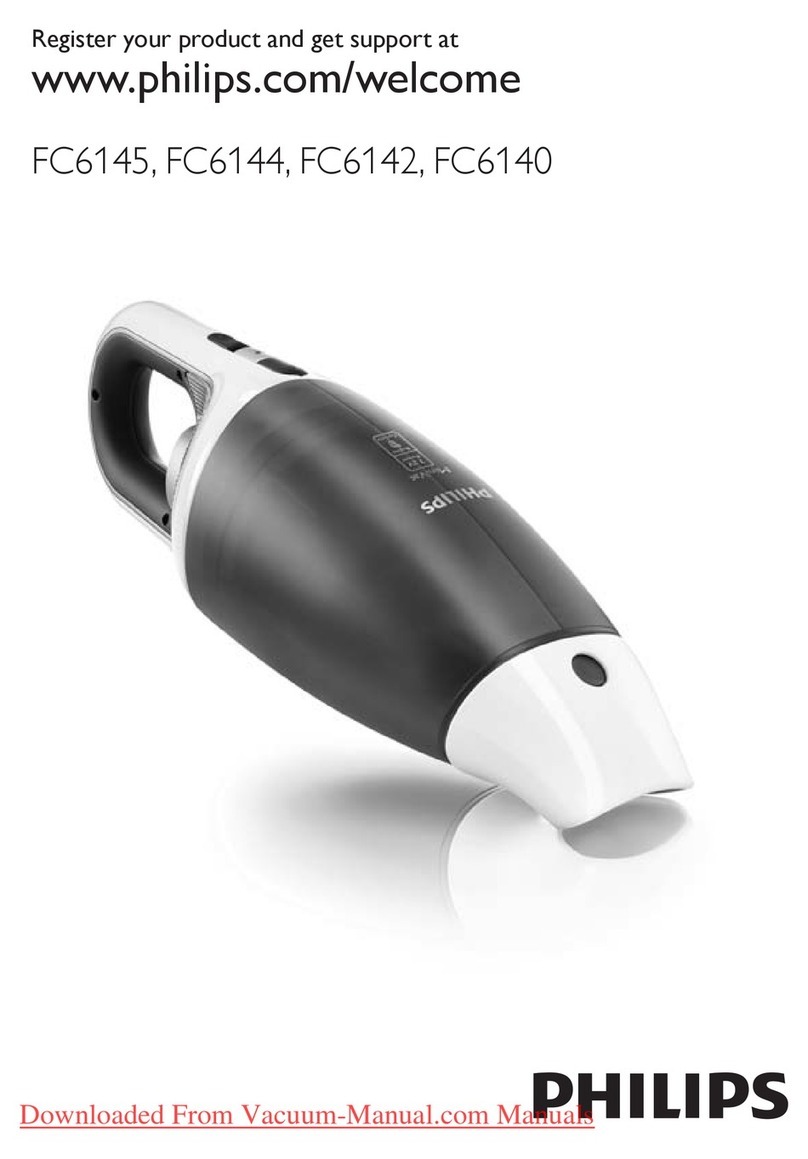Geovebt HVU-3 User manual

Version 2.0 30.01.17
HIGH VACUUM UNIT
HVU -3, -5, -7, -11 og -15
INSTRUCTION MANUAL
www.geovent.com

22
Contents
1.0 General safety precautions 3
1.1 Danger 3
1.2 Field of application 3
1.3 Technical data 3
1.4 Construction – table of dimensions 4
2.0 Installation 4
2.1 Optional equipment
2.2 Trial run – exact adjustment
3.0 User instruction – application
4.0 Maintenance
4.1 Exchange of filter medium
4.2 Trouble shooting
5.0 Liability
6.0 Declaration of conformity
1.0 General safety precautions
IMPORTANT – Please study all the instructions before
mounting and commissioning.
Please keep these instructions in a safe place and in-
struct all users in the function and operation of the pro-
duct.
Exchange of filter/maintenance should only be imple-
mented after studying section 4 thoroughly.
Avoid the dismantling of any factory-mounted parts, sin-
ce it impedes the commissioning of the equipment.
All electrical installations must be carried out by an
authorised electrician.
1.1 Danger
Explosive media – the HVU is not suitable for the extra-
ction of aluminium dust, flour, textile dust nor sawdust or
other media, which is connected with danger of explosi-
on, without specific approval from Geovent A/S. Please
ensure not to extract any of the above mentioned media,
since an explosion could be deadly dangerous.
Dismantling parts on the HVU whilst in operation could
be deadly dangerous.
Always disconnect the HVU from the mains, when
mounting parts or servicing the Unit.
1.2 Area of application
The Geovent High Vacuum Unit - HVU - (of more than
20 kPa) is suitable for vacuum cleaning of cars during
preparation, for the extraction of grinding dust, e.g. when
carrying out bodywork or in combination with Energy
Arms. The Unit is equipped with a two-step filter cyclone
with an automatic/pneumatic cleaning system and has a
filtration level of 99.9%.
The Unit may be used for the extraction of grinding dust
from hand-held rotor grinders, stationary belt sanders
and bench grinders, brake dust from cars and trucks as
well as ordinary workspace cleaning, etc.
The Unit is not suitable for the extraction of aluminium
dust, flour, textile dust, nor for sawdust or other media,
which is connected with danger of explosion, without
specific approval from Geovent A/S.
1.3 Technical data
Model Output
[kW]
Power
consumption
100% load
Max air flow
[m³/h]
HVU-3 3 6,8A 350
HVU-5 5,5 11,6A 550
HVU-7 7,5 15A 680
HVU-11 11 22A 1.180
HVU-15 15 31A 1.180
Model Max.
Vakuum
[kPa]
Filter area
[m²]
Filtration
effect
according to
BIA-test
HVU-3 23 15 99,9%
HVU-5 21 15 99,9%
HVU-7 33 15 99,9%
HVU-11 22 15 99,9%
HVU-15 35 15 99,9%
Model Sound
pressure
level accor-
ding to
ISO-3746-
1979
Compres-
sed air
tank w/1”
connec-
tion
Collection
bucket
HVU-3 72 dBA 4 Liter 25 Liter
HVU-5 74 dBA 4 Liter 25 Liter
HVU-7 78 dBA 4 Liter 25 Liter
HVU-11 78 dBA 4 Liter 25 Liter
HVU-15 78 dBA 4 Liter 25 Liter
Model Cabinet +
cyclone
ø700 mm
Corrosion
class
Weight
HVU-3 Lacquer ll 205 kg
HVU-5 Lacquer ll 232 kg
HVU-7 Lacquer ll 261 kg
HVU-11 Lacquer ll 307 kg
HVU-15 Lacquer ll 328 kg
Temperature extracted air Max 150°C
Temperature surroundings Max -10°C - +50°C
Relative humidity must be <90%

3
The sound level depends on several factors; For examp-
le where the High Vacuum Unit is placed (indoors/out-
doors), the size of the room, the temperature of the
surroundings, the acoustics and also the connection
(hose><pipe) of the Unit has an effect on the sound le-
vel.
Graphs of pressure drop for the High Vacuum Unit
1.4 Construction
Cover: Epoxy painted steel plate.
Filter medium: Spark proof aluminium-coated polyester
filter AluTex® with a 99.9% filtration efficiency. Expected
life for normal operation: 4,000-8,000 hours.
Engine/vacuum pump: IP-54 standard engine with by-
pass fan in cast aluminium. Expected life for normal ope-
ration: 20,000 hours.
Automatics: Control panel of ABS-plastic IP-55.
Table of dimensions
Type HVU-3 HVU-5 HVU-7 HVU-11 HVU-15
øD 100 100 100 125 125
Weight 205 kg 232 kg 261 kg 307 kg 328 kg
2.0 Installation
The HVU should be installed indoors, for example in an
engineering room with good ventilation in order to secure
perfect operation. For outdoor installation, always pla-
ce in an open shed as a minimum. THE SURFACE
TREATMENT OF THE HVU IS NOT SUITABLE FOR
OUTDOOR APPLICATION, SINCE THE RISK OF WA-
TER PENETRATING THE CYCLONE IS INCREASED
AND FURTHERMORE, THE ELECTRONICS COMPO-
NENTS MAY NOT FUNCTION IN FROSTY WEATHER.
The HVU is supplied in complete/assembled condition
and it has been pre-programmed, ready for connection
to the mains.
Before mounting, please make sure that the optimum
installation area is selected. Should it be placed indoors
or outdoors? Is there space enough for the satisfactory
installation and service of the HVU? What about opti-
mum connection possibilities for piping and automatics?
If at all possible, please avoid bends just before the inlet
and after the outlet, since otherwise it could reduce the
capacity of the HVU. For outdoor mounting, please take
the following aspects into consideration: Any noise nu-
isance for the neighbours, defects due to frost and keep
the engine out of heavy showers. Therefore, we recom-
mend building a shed around the HVU in order to protect
A Ø127mm Outlet
B Removable top
C Control panel with automatic start/stop and filter
cleaning
D Safety valve
E Filter cartridge - alu-coated polyester tissue - antistatic
F Ø127 mm inlet
G Collection bucket 25 litres
H Frame with holes for forklift truck
B
C
D
E
F
H
A
G
Tryktab for HVU 11 og 15 KW
3.500
Air Flow [m³/h]
[Pa]
31.500
7.000
10.500
14.000
17.500
21.000
24.500
28.000
35.000
38.500
500
600
700
800
900
1000
1100
1200
1300
1400
1500
11 kW
20 kW
15 kW
25,2 kW
12,6 kW
17,3 kW
HVU 11
HVU 15
3.500
Air Flow [m³/h]
Tryktab for HVU 5 og 7 kW
31.500
7.000
10.500
14.000
17.500
21.000
24.500
28.000
35.000
38.500
200 400 600 800
0
HVU 5 HVU 7
8,6kW
7,5 kW
5,5kW
4kW
4,6kW
6,3kW
4 kW
5,5kW
6,3kW
4,6kW
900100 300 500 700
[Pa]
Air Flow[m³/h]
3.500
Tryktab for HVU 15P, 18P og 20P
31.500
7.000
10.500
14.000
17.500
21.000
24.500
28.000
35.000
38.500
900 1100
01300 1500 1700 1900 2100 2300 2500 2700
8,5 kW
700
500
12,5kW
18,5 kW
9,8 kW
14,5 kW
21,5 kW
20 kW
25,2 kW
HVU-20PHVU-18P HVU-15P
15 kW
17,3 kW
2900
[Pa]
Værdier markeret med splede linier opnås ved
brug af frekvensomformer – 60 Hz
Værdier markeret med splede linier opnås ved
brug af frekvensomformer – 60 Hz
Værdier markeret med splede linier opnås ved
brug af frekvensomformer – 60 Hz
Tryktab for HVU 11 og 15 KW
3.500
Air Flow [m³/h]
[Pa]
31.500
7.000
10.500
14.000
17.500
21.000
24.500
28.000
35.000
38.500
500
600
700
800
900
1000
1100
1200
1300
1400
1500
11 kW
20 kW
15 kW
25,2 kW
12,6 kW
17,3 kW
HVU 11
HVU 15
3.500
Air Flow [m³/h]
Tryktab for HVU 5 og 7 kW
31.500
7.000
10.500
14.000
17.500
21.000
24.500
28.000
35.000
38.500
200 400 600 800
0
HVU 5 HVU 7
8,6kW
7,5 kW
5,5kW
4kW
4,6kW
6,3kW
4 kW
5,5kW
6,3kW
4,6kW
900100 300 500 700
[Pa]
Air Flow[m³/h]
3.500
Tryktab for HVU 15P, 18P og 20P
31.500
7.000
10.500
14.000
17.500
21.000
24.500
28.000
35.000
38.500
900 1100
01300 1500 1700 1900 2100 2300 2500 2700
8,5 kW
700
500
12,5kW
18,5 kW
9,8 kW
14,5 kW
21,5 kW
20 kW
25,2 kW
HVU-20PHVU-18P HVU-15P
15 kW
17,3 kW
2900
[Pa]
Værdier markeret med splede linier opnås ved
brug af frekvensomformer – 60 Hz
Værdier markeret med splede linier opnås ved
brug af frekvensomformer – 60 Hz
Værdier markeret med splede linier opnås ved
brug af frekvensomformer – 60 Hz
Pressure drop for HVU 5 and 7 KW
Pressure drop for HVU 11 and 15 KW

4
it from the weather and to shield against noise.
Example: Below a noise shield has been built around the
HVU and a protection roof against heavy showers.
The following installation should only be carried out by
a trained fitter.
Procedure:
1. The HVU is placed on a solid foundation (e.g. on a
concrete floor), where there is no danger of vibration
transmission. Also, please ensure that the filter can
be exchanged (i.e. as a minimum a free height of 800
mm is required).
2. Connect the piping to the HVU. On the inlet side, the
pipe may be fixed by means of a spring lock system.
Remember to seal the connection with filler and/or
tape!
3. In order to secure free mixing, the outlet should be
taken two metres up above the roof top (up in the air)
with an air velocity of 8 m/s as a minimum.
4. The whole plant/piping system should always be tho-
roughly checked for leaks, which should be sealed.
The plant may not be taken into operation for 24 hours.
Connection of the fan to the mains:
5. The connection of the electric components of the
HVU should only be carried out by an authorised ele-
ctrician.
Connecting the compressed air:
1. Connect the clean and dry compressed air. There
must be a pressure regulator. We recommend you to
install a water separator just before the HVU.
2.1 Mounting of optional equipment
Mounting of frequency converter
It is possible for us to deliver with frequency converter
and / or pressure control. See for external manual pres-
sure control.
For setting options for external frequency converter,
please refer to the supplied, separate manual.
Automatic start/stop
External start/stop (e.g. micro switch by the quick-action
coupling/connection or on/off-button on the Energy Arm)
There is a timer an manuel, which makes HVU’en to
swits off automatically after 30 minutes.
2.2 Trial run – exact adjustment
When the installation has been completed, please check
whether there is any vibration or noise nuisance from
the HVU. Please control that the complete plant is totally
tight. If any creaking noises are emitted, please locate
the leakage and seal it with filler. Furthermore, we re-
commend checking whether the HVU supplies the volu-
me of air, for which the equipment has been dimensio-
ned. Measure the air volume and ensure that it does not
exceed the amperage of the engine.
Vacuum security
The vacuum secury is adjustment from factory. We re-
commend that you readjust the vacuum securit subse-
quently.
Adjustment of the Vacuum security
Adjusted so that the valve does not open during normal
running, but opens at blocking.
1. Adjust to loosen or tighten the spring.
2. Then buckles to lock nut to secure the the spring po-
sition.
Vacuum sikring

55
3.0 Application – user instruction
The HVU may not be in operation for longer periods of
time (more than 45 min.) without opening the connec-
tions in the Channel Duct System, since otherwise the
pump will superheat and break down. Optionally, use
the built-in start/stop function.
Use
When you are finished using the unit, keep the flap open
in 1-5 seconds so that the particles are sucked away
from the vertical pipe, so that it does not fall into the
head of the operator, the next time the system is in use.
4.0 Maintenance
At least once annually, the whole point suction plant
should be overhauled by an authorised serviceman.
Periodic maintenance:
• All electric parts should be checked annually.
• In principle, the vacuum pump/engine is main-
tenance-free due to the factory-mounted com-
pletely closed special ball bearings, which do
not require any maintenance. Exchange of worn
bearings should only be carried out by an elec-
tro-company.
4.1 Exchange of filter medium
The collection bucket should be emptied when approx.
two thirds of it is full, since otherwise it may further load
the filter medium. The filter medium should be exchan-
ged after approx. 4,000-8,000 hours of operation or max.
4 years. Partly, this depends on the load on the filter, for
example whether it has been used in connection with
welding or grinding, etc.
Procedure:
1. Disconnect the Unit on the repair switch. Please en-
sure that the switch cannot be activated during the
service operation.
2. Disconnect/dismantle the compressed air connecti-
on.
3. Before dismantling the dusty filter, it is important that
the service technician is equipped with the necessary
personal safety outfit, i.e. breathing mask and gloves,
which comply with the rules of the Working Environ-
ment Service regarding work with polluted dust.
4. Subsequently, the collection bucket is dismantled by
means of the fixed spring locks. Now, with care the
bucket may be taken out. The contents of the bucket
are now to be destroyed in an environmentally sound
manner in accordance with the current rules.
5. The bucket is returned and fixed under the cyclone.
6. The top/lid of the cyclone is dismantled by uncoupling
the spring lock, and then the lid with the compressed
air tank is removed. Make sure first to disconnect the
supply of compressed air and the power supply and
not to damage the compressed air tank, when it is put
aside.
7. Subsequently, with a 17 mm box spanner remove the
three M10 bolts, which attach the filter medium to the
Unit.
8. The polluted filter medium is carefully lifted up and
placed in a large rubbish bag, which is then properly
sealed up.
9. The new filter medium is inserted and fixed to the
Unit with three 10 mm bolts.
10.The top/lid is carefully returned and fixed with a spring
lock. (Remember to connect to power and compres-
sed air again!).
11.Subsequently, the polluted filter medium is sent to
destruction at the nearest waste disposal plant.
4.2 Trouble shooting
In case of problems with reduced pressure or volume of
air, the points mentioned below may be followed when
attempts are made to solve the problems:
The volume of air or the pressure has fallen to below
the indicated volume/pressure.
• Wrong direction of rotation of the fan wheel. May be
caused by wrong electrical installation. Please doub-
le check the direction of rotation. Change two pha-
ses.
• The channel system is not tight.
• Poor inlet/outlet options close to the vacuum pump
may reduce the capacity (e.g. 90° bend just before
the inlet).
• Damaged wheel.
• The rate of rotation has been set to a lower level.
• If the temperature deviates substantially from the la-
boratory measurements, where the temperature was
20°C with an atmospherical pressure of 101.4 kPa.
• The dampers have not been properly adjusted.
• The channel or the Unit has been blocked by a
screwdriver, for instance.
Vibrations and noise.
• The foundation is not level/stable.
• Elements coming from outside have penetrated the
Unit/channel system.
• Damaged wheel or engine.
• The wheel is loose.
• The wheel is running in the wrong direction.

6
• Loose bolts or screws.
The engine is overloaded.
• The cabling to the engine is wrong.
• Defective engine – please contact the distributor!
5.0 Liability
Warranty
Geovent A/S grants a warranty for products, which are
defective; when it can be proved that the defects are due
to poor manufacture or materials on the part of Geovent.
The warranty comprises remedial action (reparation or
exchange) until one year after date of shipment. No
claims can be made against Geovent A/S in relation to
loss of earnings or consequential loss as a result of de-
fects on products from Geovent.
Wear parts like fan wheels etc. are not included in the
warranty.
User liability
In order for Geovent to be capable of granting the decla-
red warranty, the user/fitter must follow this Instruction
Manual in all respects.
Under no circumstances may the products be changed
in any way, without prior written agreement with Ge-
ovent A/S.
5.1 Pipes and fittings
Start by loosening the 2 bolts so you can easy connect
the pipe. Do NOT, under any circumstance, lubricate the
pipes or rubber with any type of oil or grease.
Metal flap valve type ø50 - ø50 is secured by inserting it
into the pipe and then tightened by tapping it in. As show
in the picture below.
We recommend that you fasten the valve with a small
screw through the pipe and the valve.
Basically, the flap valve is for mounting in pipes.
It is in many cases possible to mount it in branch pipes,
bends and by filing the tube on the inside. Then it is pos-
sible to tap in the flap valve.
This may not always be possible.
omstændigheder

77
6.0 EF-HOVEDGADEN 86 • DK-8831 LØGSTRUP
Hereby declares that:
The product: High Vacuum Unit
Models: HVU-3, HVU-5, HVU-7, HVU-11 and
HVU-15
has been manufactured in compliance with the directi-
ons of the Directive Council of 14 June 1989 in common
approximation to the legislation of the member states
regarding machine safety (89/392/EEC amended by the
directive 91/368/EEC) with special reference to appen-
dix 1 in the Directive regarding basic health and safety
requirements in connection with the construction and
manufacturing of machinery.
Council Directive 2006/42/EC (May 17, 2006) of the
European Parliament on machinery, and amending Di-
rective 95/16/EC.
EN ISO 14121-1:2007 Safety of machinery - Risk asses-
sment - Part 1: Principles
EN ISO 12100-1:2005 Safety of machinery - Basic con-
cepts, general principles for design
EN ISO 12100-1:2009 Construction and design
Part 1: Terminology, methodology
EN ISO 12100-2:2005 Basic concepts, general princip-
les for design
EN ISO 12100-2:2009 Construction and design
Part 2: Technical principles
Date: 30/01-17
Position: Managing Director
Namn: Thomas Molsen
Underskrift : ____________________________
6.0 Declaration of conformity
This manual suits for next models
4
Table of contents
Popular Vacuum Cleaner manuals by other brands

Kärcher
Kärcher Sensor XP15 operating instructions
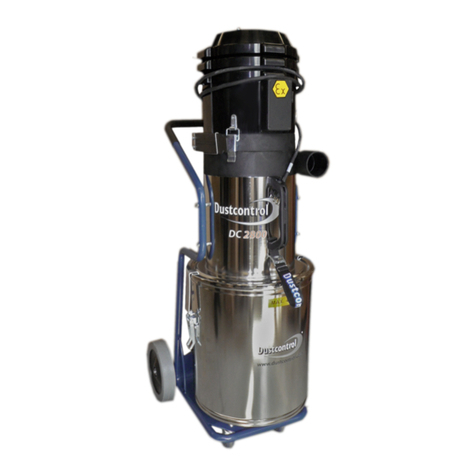
Dustcontrol
Dustcontrol DC 2800 EX RVS Original instructions

Bissell
Bissell SPOTCLEAN 2513 Series manual
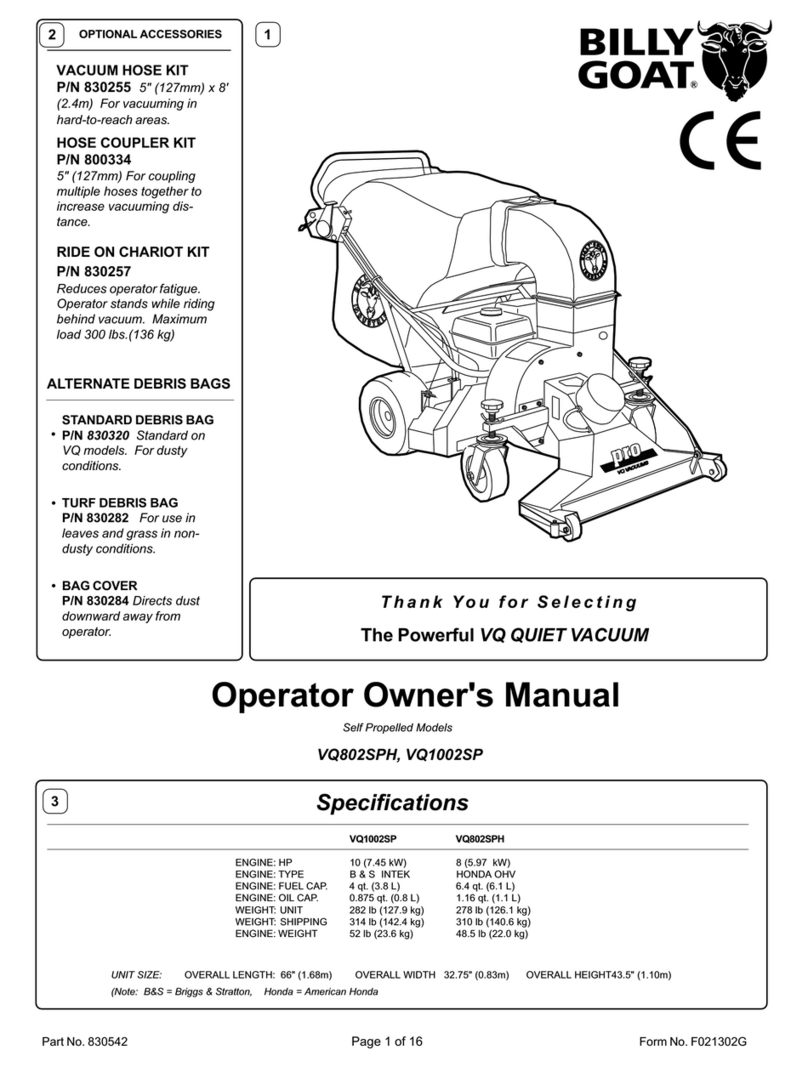
Billy Goat
Billy Goat VQ1002SP Operator owner's manual
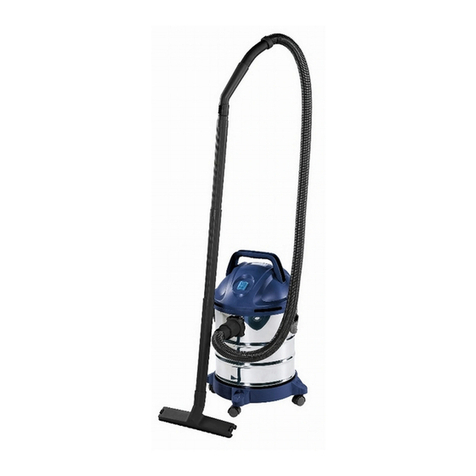
EINHELL
EINHELL BT-VC 1250 operating instructions
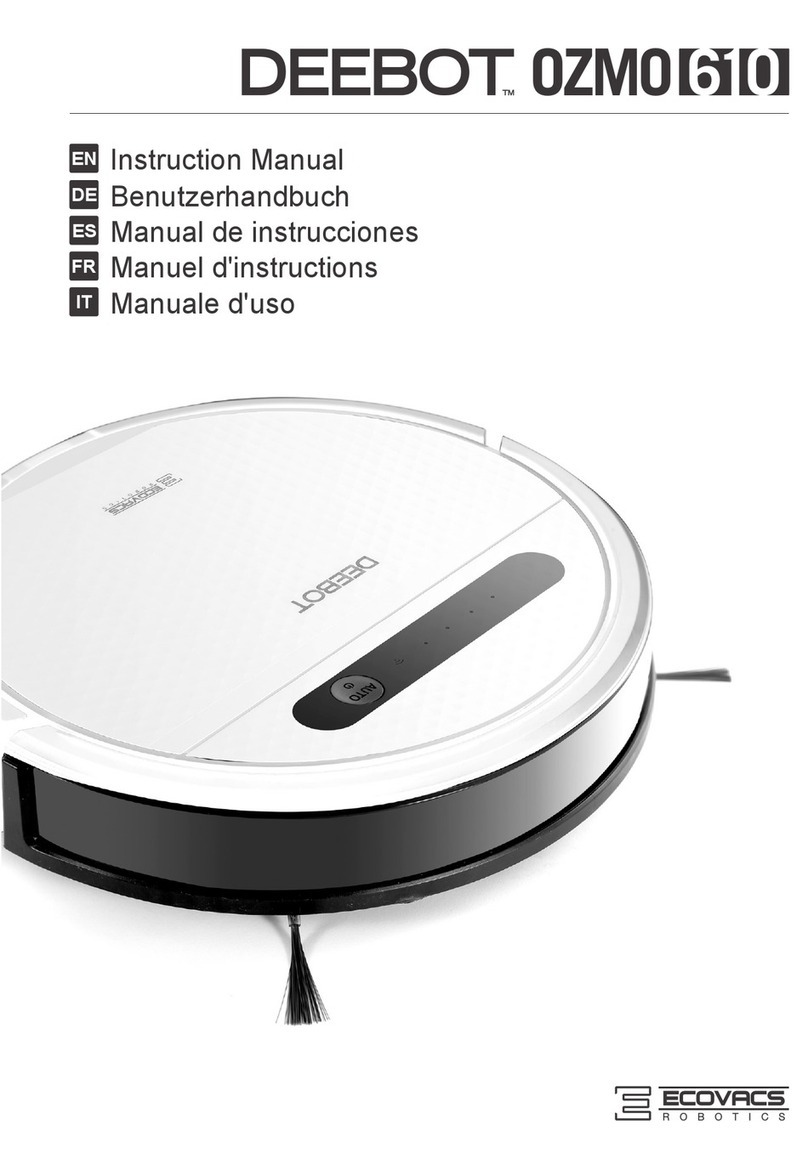
ECOVACS ROBOTICS
ECOVACS ROBOTICS DEEBOT OZMO 610 instruction manual


